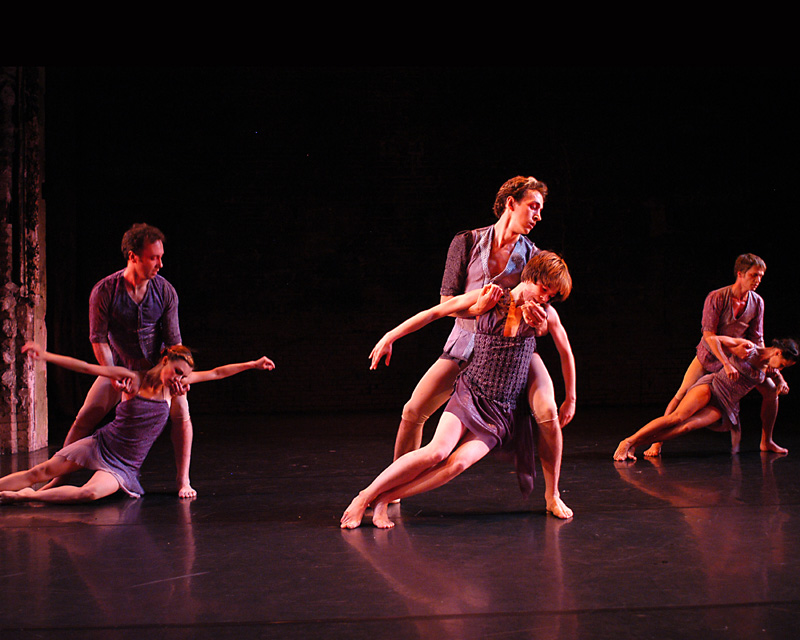Wordless Drama: Freeh at the Southern
Lightsey Darst reads Penelope Freeh's "Witness and other dances" performed recently at the Southern Theater.

Works of art cast shadows—sometimes simple echoes, sometimes castles whose crenellated outlines do not, at first glance, correspond with the work at hand. Penelope Freeh’s work is of the second category.
On stage she sends herself or her dancers prying or crawling through intricate convolutions of the body, the forms technically rigorous, twisted ballet steps rather than easily-read gestures, severe rather than flowing, with every muscle strained, some contortion of the hip or flexed foot or even the face rending or reining in the beauty of ballet lines, but on the back wall of the viewer’s skull an opera or an immense gothic novel unfolds its pack of characters, its rich panoramas, and its myriad scenes of comedy, tragedy, and the in-between.
To create this effect, Freeh doesn’t use much—no text, no video—but each detail of her design speaks. Costume: a shimmering amethyst skirt, rucked and hung with gold tassels, says our heroine is a bit of a gypsy, a bit of a vamp; a corset dress with a short swagged skirt, worn with red retro heels, gives us a cross between a Western whore and a Renaissance lady; these marvelous get-ups are the work of Mary Hansmeyer.
Props: droopy, oversized, slightly dirty wings descend slowly from the ceiling—a woman’s far-flung aspiration; a delicate teacup, fought for, is a doubtful goal, a decoration rather than a cure. Music: a tapestry of baroque and modern, harpsichords and broken percussion, suggesting want, betrayal, need, urge, chaos, longing.
In their design, Freeh’s dances reach out for other artworks—Edward Gorey’s pen and ink grotesqueries; Kym Longhi’s fine beading on a corset or choker; the intricate and arduous network of a lace shawl or a mind or a Jim Diebold city; Richard Barlow’s colored cages (the work of these three local artists is displayed in the Southern’s lobby); Bach’s twisting, mathematical music, Hopkins’s tortuous poetry, Piranesi’s cobwebbed prisons, Jeanette Winterson’s erotic novel tangles. . .
Do not, however, forget about the body. Freeh won’t let you. Each moment is invention, as dancers wind around each other in snakelike, Mannerist partnering or shoot out laser legs below rococo arms. Freeh has only one signature move, which she uses almost as a neutral position: the dancer balancing on her sacrum, arms and legs bent but held up in a wanting reverie. For the rest, Freeh is concentrates more on working the body through positions than on style—which amounts to a style, though a singularly unindulgent one. She doesn’t pursue beauty but she moves through it—a lift in which a woman swings around and over a man’s shoulder, a buoyant arabesque—on her way to a more interesting wound. Limbs become other; every pose is injured, altered. Above all, everything is changing, so that looking away for one second means missing a critical permutation.
Freeh’s extraordinary concentration on steps does occasionally become a weakness. The fine level of detail obscures larger passages; pieces that seem to have meanings do not quite communicate these meanings through the dense haze of steps. If the witnessing of “Witness” (the evening’s stand-out) refers to something more specific than the witnessing of dancers by audience or dancers by other dancers or the general circumstance of being seen, it is not evident. The modern-inspired “I Overestimated the Distance Between Us” suffers a different problem: here, without ballet as a spine, Freeh’s steps become unfocused, her invention fails, and she sends dancers out in familiar shapes and arcs.
“Overestimated,” though, contains the night’s most moving moment. Eric Boone begins in a spotlight; Stephanie Fellner circles him just outside the light. They come together, but while the woman is grasping and ecstatic, the man looks over her head, beyond her; they fall apart. He cradles her in a crabwalk, then lets her go. They alternate in the spotlight, reaching for each other and missing. The distance, the misunderstanding between them, is like a bad marriage, or the inevitable bad moments in a good marriage—when you miss your other, when you think you’re not loved back. That Freeh can work in such large emotion, as well as in her more intellectual, technical, rigorous mode, is—even if the two do not yet come together—a sign of her talent and growing choreographic ability.
Freeh’s excellent dancers all have reason to thank her for making them look even better than usual (Robert Haarman and Justin Leaf in particular). The match between Freeh’s choreography and Stephanie Fellner’s dancing, though, is of another order. Freeh gives Fellner’s vulnerability dynamic form, while Fellner gives Freeh’s rigorous choreography a human pulse.